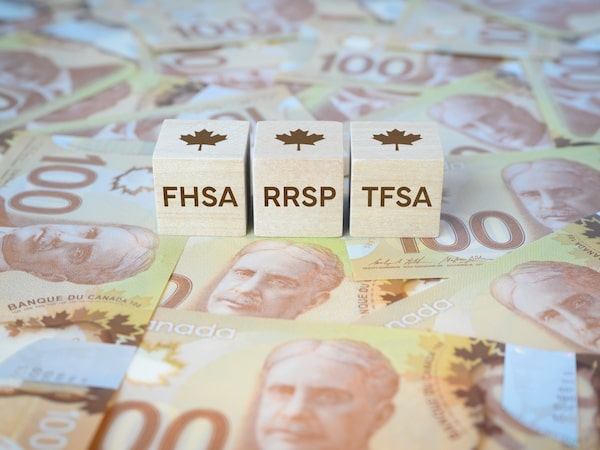
Clients must decide whether to contribute to an RRSP, TFSA, FHSA or all of them if they qualify.Kenneth Cheung (kennethcheungphoto@gmail.com)/iStockPhoto / Getty Images
Sign up for the Globe Advisor weekly newsletter for professional financial advisors on our sign-up page. Get exclusive investment industry news and insights, the week’s top headlines, and what you and your clients need to know. For more from Globe Advisor, visit our homepage.
Canadians have several tax-efficient saving and investment vehicles at their disposal, from registered retirement savings plans (RRSPs) and tax-free savings accounts (TFSAs) to the new tax-free first home savings accounts (FHSAs). But with the increased cost of living expenses, fully funding registered accounts may not be an option for many, leading to questions about how best to contribute.
According to a recent Angus Reid Institute survey of Canadians, a smaller financial cushion has meant that two in five individuals don’t contribute to a TFSA or RRSP annually and one in five are contributing less than half of their annual limit. One in 10 Canadians maximize their contributions each year.
For advisors, working with clients to navigate registered account contributions means taking a deep dive into their tax situation, their goals and the purpose for which the money will be used to find the best possible strategy.
Shiraz Ahmed, senior financial advisor, portfolio manager and founder of the Sartorial Wealth team at Raymond James Ltd. in Mississauga, likens finding the best combination of tax-efficient accounts, contributions and investments to getting the temperature of warm water just right – everyone’s mix of hot and cold will be different.
“As an advisor, we’re agnostic on all of these accounts,” he says. “They’re all account types with different tax attributes and you should be using them – ideally all of them if you’re eligible.”
“If not, you want to go through a little bit of an order of operations on which one’s going to put you further ahead,” he adds.
Decision process
As Pina Kitagawa, principal of financial planning services at Kerr Financial in Toronto explains, helping clients make the most of these accounts starts with eligibility.
For example, the FHSA, introduced in 2023, is only available to first-time home buyers. Being aware of a client’s available contribution room is also a crucial step.
“All of these accounts have a penalty for overcontribution of 1 per cent per month that you’re overcontributed and we’ve seen this add up over time,” Ms. Kitagawa says.
There are also several nuances to consider along the way. Through a holistic, long-term analysis of the client’s situation, Aaron Hector, private wealth advisor and certified financial planner at CWB Wealth Management in Calgary, looks to identify the client’s goals and timelines for needing the money, while gaining clarity around their marginal tax rate via their current income levels, their future income potential and anticipated retirement income.
“Understanding the income and the timing of when changes in levels of income might happen help determine when you’re going to use one account over the other,” he says. “Then, the flexibility comes into it too.”
Why FHSA contributions may take priority
When clients have a goal of owning their first home in the next 15 years, the new FHSA should take precedence, Mr. Hector says, assuming they don’t have short-term needs for the money.
“This new account jumps right up to the very top of the list in my mind, just because it’s a hybrid of the best parts of an RRSP and the best parts of a TFSA, so long as you’re using it to buy a qualifying home,” he adds.
Even for those who are eligible but may not want to purchase a home, Ms. Kitagawa says the FHSA can still be a good starting point.
“You can make those contributions and you can then transfer those assets to an RRSP if you don’t want to buy a home,” she says. “That means now we’re talking about additional RRSP room that you wouldn’t normally have and can’t get otherwise.”
Why choose RRSPs
For a Canadian with T4 earnings, RRSPs are one of the few tools they can use to help lower their taxable income, Mr. Ahmed says. Clients with the funds to make an RRSP contribution – or even an FHSA contribution – can also maximize this by taking advantage of the “waterfall method,” in which they use their tax refund to make a TFSA contribution.
“If you’re trying to maximize saving and you don’t have any other major variables out there such as debt or something you’re trying to service, then you can use that refund to do that,” Mr. Ahmed says.
When debt repayment is an issue, accelerated RRSP contributions may make sense because the extra cash flow generated by a tax return can also help pay debt down faster, says Wendy Brookhouse, financial advisor and money coach with Black Star Wealth in Halifax.
When TFSAs should take the lead
In most cases, advisors say TFSA contributions should be made when the client anticipates needing access to the funds in the short or medium term – as the money can be withdrawn without penalty – or when they expect a client’s income to be higher in retirement than in their working years.
The TFSA can also be useful for clients who want to see how their financial situation looks toward the end of the year before they contribute to one of the other accounts, Ms. Brookhouse says.
“You can give yourself that ability not to make that decision right away,” she says. “You could use your TFSA to accumulate through the year and make a final decision based on how your income profile went.”
For more from Globe Advisor, visit our homepage.